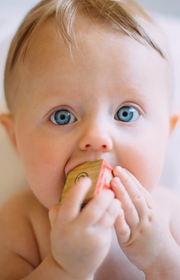Baby vs. Toddler
If you have a baby or a toddler, you are likely well aware of the progression of their growth. One moment they are babbling and cooing, drinking only milk or formula, and depending on you for everything. In the blink of an eye, you have a walking, talking toddler happily chewing on solid foods and sharing their thoughts and opinions on the world around them.
Babies grow fast—you can say in the blink of an eye. With such growth, their needs also change rapidly, and you have to adapt to each new phase of life.
But when exactly does a child transition from a baby to a toddler? We delve into the critical baby vs toddler question and share everything you need to know about their development, diet, and other important details. This will help prepare you for your child’s growth and know what to expect.
Growth and Development of Babies
Babies are infants between the ages of 0 and 12 months old. At first, they behave instinctually to express their needs—they fuss or cry when hungry or uncomfortable. They respond to touch, and their movements are mostly reflexive.
As your baby’s brain develops over time, they will be able to think more clearly and be more deliberate about their behaviors and actions.
Babies have very good hearing and listen to and soak in language, speech, and information. They will soon start responding to loud, high-pitched sounds. Your baby will also begin interacting and communicating with you through facial expressions, signs, gestures, and sounds. As they learn, they will be more precise about their feelings and emotions.
Baby vision develops very quickly, too, but is still weak at this stage. They start by exploring their fingers and toes and entertain themselves with whatever they can get their hands on.
Babies also quickly form attachments to their parents and primary caregivers. They develop emotional and social skills as they build bonds of love and trust with those around them. How their caregivers interact with them will set the foundation for their associations with others.
Some of the things that babies can do as they grow include smiling, clapping, waving, crawling, picking up things, and babbling. By the time they are five to six months of age, they can sit up with little to no support.
As months pass, your baby will also learn to reach out, focus its vision, stand up, and walk with support, if not independently. They will start recognizing objects by their names and understanding basic verbal commands.
Growth and Development of Toddlers
The Centers for Disease Control (CDC) states that toddlers are between one and three years old.
At this age, your child would have grown to about triple their birth weight. You’ll see so many other changes in your toddler besides physical development. Toddlers will begin to utter a few words and connect more objects with their names. They also become more independent and learn to do things on their own.
Toddlers’ motor skills improve very quickly, and they will be able to walk unassisted, including backward and sideways. But the movements may still be uncoordinated and unsteady, which is where the term “toddling” comes from.
Your toddler will soon be able to climb up and down stairs, jump, squat, throw a ball, and play simple games. They will master the alphabet, recite rhymes and songs, and distinguish between different colors and shapes. During this phase of life, toddlers are incredibly curious and absorb everything quite quickly.
Most of this development seems to be accelerated when toddlers turn one. Kids of this age also begin to sleep through the night for eight to 12 hours—they will no longer wake up hungry in between. They still need a nap or two every day for healthy growth and development.
The American Academy of Pediatrics (AAP) says that toddlers should sleep for a total of 11 to 14 hours every day. Although your child’s active exploration and independence may mean they will resist naps, they will still most likely sleep uninterrupted for most nights.
What Are the Common Diseases Among Babies and Toddlers?
Some illnesses are to be expected in childhood and affect a vast majority of babies and toddlers at some point or another.
Here are the most common childhood conditions:
- Fever
- Cold
- Cough
- Sore throat
- Diarrhea and vomiting
- Skin rashes
- Earache
- Asthma
- Bronchiolitis
- Chickenpox
- Measles
- Mumps
- Croup
- Urinary tract infections
- Scarlet fever
- Whooping cough
Caring for a sick baby or toddler can be stressful. Consult your pediatrician for advice on your child’s illness. They will diagnose your child’s condition and prescribe the correct medication and treatment.
What Are the Recommendations for Feeding Babies?
Babies need constant care and feeding to ensure optimum growth and development. It also lays the foundation for a healthy life for the following decades.
Breastfeeding
During the first six months, breastfeeding is best for babies. Breast milk has a unique blend of nutrients that make it the ideal infant food.
Some of the nutrients in breast milk include:
- Lactose
- Fatty acids
- Vitamins
- Minerals
- Amino acids
- Enzymes
Breastfeeding promotes healthy digestion, brain development, and immunity. It protects babies from respiratory and ear infections and other illnesses.
Mothers also benefit from breastfeeding as it reduces the risk of the following illnesses:
- Breast cancer
- Ovarian cancer
- Endometrial cancer
- Hypertension
- Diabetes
You can continue breastfeeding until your little one is a year old (and even after that if both of you are willing). If you begin the weaning process before your baby is a year old, make sure that you feed it iron-fortified infant formula.
Exclusively or predominantly breastfed babies need to supplement their diets with vitamin D, which is crucial for strong bones. They can easily become deficient in this nutrient, more so during the winter when they get low sun exposure. Babies must get 400 IU of vitamin D every day. Consult your pediatrician and ask if you need to think about supplementation.
Breastfed babies eat more often than formula-fed babies—their meals are spaced out between one and three hours. Be prepared to feed your little one on demand, which should be around eight to 12 times around the clock.
Infant Formula
Infant formula is healthy, safe, and an excellent alternative to breast milk.
Pediatricians may also endorse it for breastfeeding mothers in certain situations:
- Low milk supply
- Sore or painful breasts
- Certain illnesses
- Breast surgery
If you choose infant formula, make sure that your product of choice meets the US Food and Drug Administration’s (FDA) stringent safety standards. It should also contain all the nutrients that your baby needs for optimum health.
Note that formula-fed babies usually don’t need vitamin supplementation—infant formula should have all the essential nutrients they need.
Babies fed with formula may go a little longer between feeding sessions than breastfed babies, around two to four hours.
Soft Foods
Once your baby is six months old (time flies by fast!), you can start feeding them soft foods, such as mashed peas, potatoes, carrots, etc. Once they reach this stage, feed them healthy, nutrient-dense foods. They will hopefully learn to appreciate a wholesome diet at a very early age, laying the foundation for a healthy lifestyle in the future.
What Are the Recommendations for Feeding Toddlers?
Here are some important recommendations for feeding your toddler:
A Regular Diet
Once your child is a year old—officially a toddler—they should join you at the table for meals. This will help them learn what mealtimes are: the opportunity for the family to bond and share food at regular intervals each day. Ensure that your toddler eats different kinds of foods, such as vegetables, fruits, grains, proteins, and dairy.
Many toddlers are very picky eaters. Don’t be surprised if your toddler likes a particular food one day and hates it the next; do your best to roll with their moods.
Serve your toddler small portions of different food groups and colorful, flavorful foods so they will enjoy mealtime. Encourage them to enjoy the flavor, color, and texture to develop a lifelong appreciation of food.
Toddler Formula
Toddler formula is a great way to supplement your child’s diet with essential nutrients. It is especially handy for picky eaters who make a fuss about certain foods. It ensures your child gets all the vitamins, minerals, and nutrients they need for their growth and development.
Toddler formula is designed for kids aged 12 to 36 months.
Note that toddler formula should not be your little one’s sole source of nutrition. Use it to complement your child’s transition to a regular diet of healthy solid foods and milk.
Else Nutrition: Something Else, Something Better

If you’re looking for the highest-quality products for your child’s health, check out Else Nutrition. This plant-based toddler formula is organic, non-GMO, dairy-free, soy-free, and chemical-free.
98% of the formula only contains three simple, healthy, and natural ingredients: buckwheat, tapioca, and almond. The remaining 2% is derived from responsibly sourced natural ingredients.
Together, these tolerable and easily digestible ingredients give your toddler all the essential nutrients. There is little to no risk of unpleasant intolerances, sensitivities, and allergies.
Choose a healthy, clean, sustainable toddler formula for your child’s nutritional needs—choose Else Nutrition.





